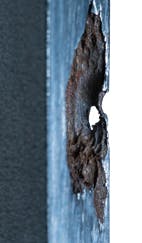
Author: Jamie Hunt
A grade's resistance to pitting corrosion can be estimated and calculated by a PRE value or PREN (Pitting Resistance Equivalent Number). This number is an approximate guide for the corrosion resistance of each Stainless Steel grade.
The Pitting Resistance Equivalence Number (PREN) is a measure of relative pitting corrosion resistance of stainless steel in a chloride-containing environment.
 |
Pitting corrosion is a localized form of corrosion by which cavities, holes or ‘pits’ are produced in the material. In stainless steel it is where the material has been eaten away to form cavities. It not only results in a sub-standard appearance but it can also reduce the structural integrity of the material. It usually results from chemical or mechanical damage to the protective oxide film. This commonly occurs in high Chloride salt-water environments. |
PREN (Pitting Resistance Equivalent Number) is a predictive measurement of a stainless grade's resistance to localized pitting corrosion based on its chemical composition.
The higher the PREN-value, the more resistant the stainless is to localized pitting corrosion by chloride-containing environment.
Stainless Steel is more resistant to localized pitting corrosion by chloride as its PREN Value increases. Stainless grades with a PREN value greater than 40 are considered ‘Super’ (such as Super Duplex 2507) making it suitable in submerged salt-water applications.
PREN = %Cr + 3.3 x %Mo + 16 x %N
PREN = %Cr + 3.3 x %Mo + 30 x %N
Calculate your own PRE value by selecting your stainless grade and entering the element percentages. Your PRE value will appear below:
| % Cr | %Mo | %Ni | %N | PREN | |
|---|---|---|---|---|---|
| 410 | 11.5 - 13.5 | 0.75 | 11 |
| % Cr | %Mo | %Ni | %N | PREN | |
|---|---|---|---|---|---|
| 304 | 18.0 - 20.0 | 8-10.5 | 0.1 | 19 | |
| 316 | 16.0 - 18.0 | 2.0 - 3.0 | 10.0 - 14.0 | 0.1 | 24 |
| 316LHiMo (Bumax) | 16.0 - 18.0 | 2.5 - 3.0 | 10.0 - 14.0 | 0.1 | 25 |
| 254SMO (6Mo) | 20.0 | 6.1 | 18.0 | 0.2 | 43 |
| % Cr | %Mo | %Ni | %N | PREN | |
|---|---|---|---|---|---|
| 2205 | 22.0 - 23.0 | 3.0 - 3.5 | 4.5 - 6.5 | 0.14 - 0.20 | 36 |
| 2507 | 24.0 - 26.0 | 3.0 - 5.0 | 6.0 - 8.0 | 0.24 - 0.35 | 41 |
Rust and tea-staining can occur from the oxidization of Iron in the Stainless, especially in a coastal environment, such as rust on wire rope on coastal balustrades. This can be avoided by:
Rust can also be caused by Iron contamination from tools that have also used with Carbon Steel.
Galvanic corrosion can also occur with dissimilar metals, which could more accurately be described as ‘corrosion accelerated by galvanic action. This is where two dissimilar metals (such as Stainless and Aluminum) in contact with an electrolyte (such as salt water) creates an electrical current that accelerates corrosion.
Jamie Hunt is the CEO of Anzor Fasteners LLP, with 23 years of procurement and supply of Stainless Steel Fasteners and Hardware under his belt. He also has Olympic yachting experience and is a Certified ISSF Stainless Specialist.
Jamie is a member of the Australian Stainless Steel Development Association and has written many articles including "The Stainless Steel Guide", "Can you paint stainless steel?" and "Are stainless fasteners OK with treated timber?". Check out Jamie on his LinkedIn profile for more information.
Build Your Deck Faster With Our Decking Screw Calculator
Super Duplex 2507 Stainless Steel for Engineering & Manufacturing
To receive useful info and product updates add your details below